I get a lot of questions about wiring motorcycles. Sometimes people are just trying to fix their blinkers and aren’t familiar with how motorcycle electrics work – but more often than not I get requests about trimming down electronics for custom riders.
An essential part of building any sort of chopper, bobber, cafe racer, brat bike, or rat rod is getting rid of all the unnecessary items. These days I just grab my wire snips and start trimming away with no regard for common sense and caution – but if you are working with your first wiring loom I’m going to try and give you some guidance right now.
You might have checked the wiring diagram for your bike already and seen something like this:
The above diagram is from a Honda CB750 Custom dual cam bike. Lots of 70’s and 80’s bikes will look the same, especially the four cylinders.
If you are trying to build a stripped down bike there is a lot going on that you don’t need. A lot of the controls can be removed, blinkers, gauges and indicators, relays and switches. It doesn’t take a whole lot of wiring to keep a bike on the road, especially if you don’t want to cater to the law word for word. By trimming down the wiring you’ll be saving complexity, saving weight, and cleaning up the look of your bike.
Below is a generic wiring diagram I whipped up that can be used as a guideline. I tried not to tailor it specifically to any particular model of bike, and I tried to make it as easy to understand as possible – but really any 70’s and early 80’s model bike with carbs will adapt to this diagram quite well. This diagram is setup to run a headlight and brake light, keep your battery charged, and have a keyed ignition. Personally, I sometimes strip my bikes even further, but I’ll mention that further down the page.
When working on your existing wiring loom it is best not to just start cutting wildly (like I do!) but to be very careful. Inside your headlight is where much of the wiring converges, so is a good place to start. Remove your headlight and start trimming back the sheaths. Slice back the sheaths of the wiring loom as far as possible to expose the wires inside.
If this is your first electronics exploration, start with something easier. Pick a fixed item you’d like to remove and trace the wires. An easy starting point is the blinkers. To remove your blinkers, unbolt them one at a time, then trace the wires through the cut open sheath. The grounding wire will most likely be shared with your headlight and gauges depending on the bike, so don’t trace the black wire, just unplug it. But, you should be able to follow the positive lead from each blinker all the way to the flasher relay which will be near the battery and rectifier under the seat. You can remove all of this wiring, the relay, and of course the blinkers.
Keep going one item at a time. You should DEFINITELY be using a volt meter. IF YOU DO NOT HAVE A VOLT METER GO BUY ONE NOW! You can buy a cheap volt meter from Harbor Freight or Northern Tool for around $10 that will look something like this:
It will do everything you need. Or if you are a stickler for high quality tools like I am you can spring for something like a Craftsman Multimeter for around $50-60. This is what I use – though I must state, I only use 10% of what this device is capable of.
It should be noted that my diagram caters to my desires – I generally remove the switch controls on the left side of the handlebars, and the ones on the right if possible (often times the throttle housing and switches are a single unit). I replace my controls with simple switches picked up from radio-shack, and mount them where ever pleases me at the time. Sometimes I’ll make a little plate to mount them on the dash:
Or sometimes I’ll just stick them to the headstock, or under the seat so they are out of the way completely. The above KZ440 I didn’t remove a lot from. In this picture I had one switch overriding the keyed ignition, and another activating the starter. It was kind of a weird setup, but the only photo I have handy.
But anyway…..
When removing things you always want to make sure they are either not being utilized or serve no essential purpose. If you have the bike running and you’re watching voltage on a particular item (for example: a neutral switch), you’ll understand when it’s being used and when it isn’t and this will help you make a decision of whether or not it should be cut out.
I will usually ditch the:
- Gauges
- Ignition
- Blinkers and Flasher relay
- Left controls (right side depending on throttle setup)
- Side stand switch
- Oil pressure switch
- Neutral switch
- Maybe a front brake switch depending on the type
- License plate light
My general goal isn’t to be legal. You know what I’m after.
There is a lot more involved with doing a clean wiring trim than what I’ve mentioned here, but hopefully this helps push you in the right direction. If you have questions, please ask them either here in the comments or on my new Motorcycle Repair Forums. I do my best to help out everyone who posts.
Also – for some of you who are more adventurous and are looking for a hardcore diagram for modifying a kickstart only bike to run sans battery – have a looky:
I won’t explain the above right here right now – but if you’re looking to go as low profile as possible and have questions, please let me know. On many bikes you’ll need to introduce a capacitor or two and possibly a particular regulator unit.
Cheers!
-Evan
ADDENDUM:
A reader recently had a very note worthy comment. My diagrams above have the brake light controlled by the same switchable power source as the headlight. This means that you must turn on the headlight for the brake light to be active. While I tend to like this setup – it isn’t necessarily the safest. If you forget to turn on your lights, your brake light won’t work. Hans graciously sent me an edited version of my diagram with the adjustment on it. Have a look:
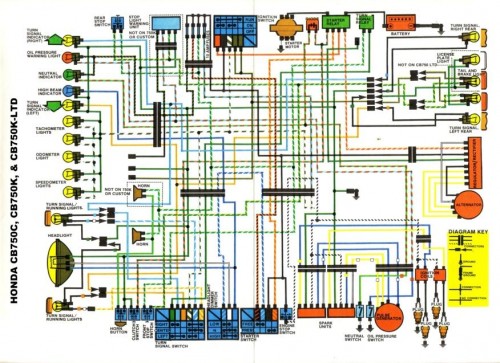
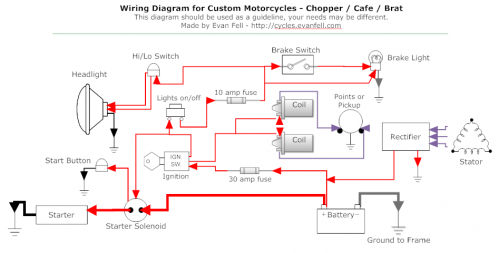
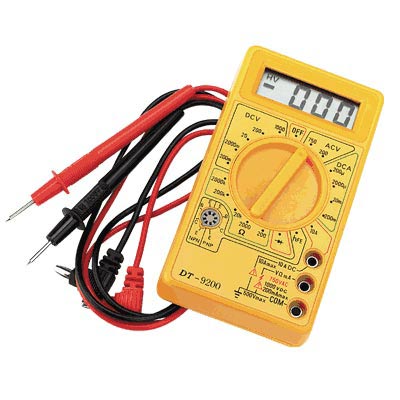
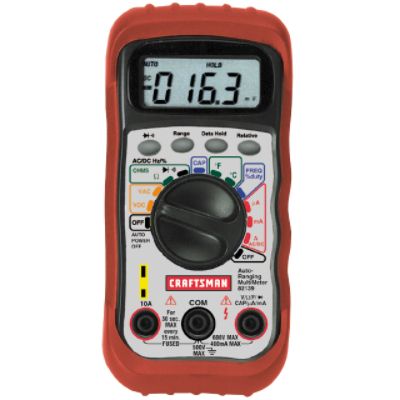

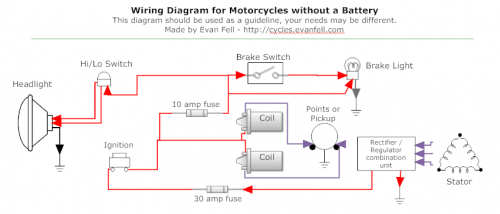

I’m looking for a copy of some of the early wiring diagrams from “the good old days”– 60s, 70s & 80s— preferably the Santee or Ron Finch but other wiring diagrams specific to the KZ1000.
I just got a very clean 78 model but the harness was junk.
Can anybody help with this
Mike G.
[Reply]
Hi Mike –
You can follow the link above (comment #2) to a wiring diagram provided by Amen – should be very similar to anything provided by Santee. It’s also quite similar to my diagram in this very post.
You can find a wiring diagram for you 1978 Kawasaki KZ1000 here: http://cycles.evanfell.com/2010/03/wiring-diagram-for-1977-1978-kawasaki-kz1000-and-kz1000ltd/
[Reply]
Great write-up! Wish I’d had something like this years ago. Does a better job of explaining a bike’s electrics than anything I’ve seen. Instead of trying to decipher the complexity of one of those stock diagrams, you can build off of these simple diagrams. Kudos!
[Reply]
Wow, this looks like such a valuable resource. I am still getting into bikes and fixing them (trying to build one with my dad) but this looks really cool. Will be checking back for more info.
[Reply]
I need a wiring diagram for a HondaCBR600F2. Can you help me find one.
[Reply]
like your web page.
i’m building a vintage street tracker out of an old sportster. i want to run just the min. i am running a magneto and was wondering if i could run my headlight and taillight with just the mag and eliminate the gen.?
i want a high-lo, rear brake light, kill button,i have a toggle switch on the mag for on-off, oil pressure indicator light, and a high beam indicator light. is this possible?
[Reply]
hello finally a wiring diagram but i need to know will it work for a cb650 1980 honda bobber it needs to be ca state legal
[Reply]
Hi Lloyd,
California requires blinkers – most states do. There are no blinkers included in my diagrams above but they can easily be added on. Personally I like to risk it without blinkers (but I don’t necessarily recommend that you do the same).
[Reply]
nixy Reply:
March 26th, 2011 at 8:15 pm
hi i want to do a basic wiring job on a xj900f can i ditch the tci unit and run the ign coils straight off the pickup coils?,how do i hook up the reg/rec? cheers nixy
[Reply]
Hey, evan, great writeup,
planning on using the diagram for a cb360 cafe build im in the middle of,
if i recall correctly, there are only 20 states that require turn signals on the bike, i may be wrong though.
i do have a question for you,
i have heard conflicting sides of the story when it comes to battery elimination.
on one side, i’ve heard that its perfectly fine to run a points bike just off the factory generator,
and i have also heard that if it doesnt have electronic ignition, you either need a battery or magneto to make it work,
now i can understand needing a battery or a magneto if you have a heavy electrical load, but if you only have headlight, tail and brake, and ignition, it should run fine, with just the factory generator, correct?
also, i know you can use a radioshack rectifier, but in your diagram you have it wired as a regulator/rectifier combo unit.
could you wire the stator directly to the rectifier, and then run a regulator in line?
[Reply]
Thank you for taking the time to put your wiring diagrams on the net. Very helpful indeed. As for blinkers in CA, I believe you can’t manufacture a motorcycle without the blinkers as for your garage chop you should be O.K.. You just have to use hand signals to comply with vehicle codes. I have yet to be stopped for not having blinkers on my xs650 yamabobber for quite a few years now.
[Reply]
@steve – yes, you are right about blinkers in CA. However, if you are riding at night you are technically required to have them. I have never had any issues either.
[Reply]
Thanks for the wiring posts, they have inspired me on my cb350 project. I want to run sans battery to have the kick start only. I am having a problem working out the AC generator to stock regulator and rectifier to get proper output while keeping the special smoke in the rectifier. Furthermore, you mentioned the use of a capacitor, the local guys say it can’t be done properly. How can I prove em wrong?
Thanks again
[Reply]
like your web page.
i’m building a vintage street tracker out of an old sportster. i want to run just the min. i am running a magneto and was wondering if i could run my headlight and taillight with just the mag and eliminate the gen.?
i want a high-lo, rear brake light, kill button,i have a toggle switch on the mag for on-off, oil pressure indicator light, and a high beam indicator light. is this possible?
[Reply]
hey evan, thanks for taking the time to share your knowledge. just getting into a cafe build and having wiring problems. what does the rectifier do does the battery feed to the rectefier go thru the ign. switch first. my problem is i keep blowing fuses, seems like power going thru my key switch and grounding out when the switch is bolted to the frame causing the fuse to blow. any ideas thanks
[Reply]
Thanks!!!
I rbuild my old kz1000 to custom bike, my wiring drove him crazy!!!
i search long long…time for easy wiring diagram.
today i will start work based on your direction.
thanks again Evan.
[Reply]
@Steve – It will depend greatly on the model of bike. I’m not sure specifically about the CB350. The capacitor setups were traditionally done Triumph guys. There is a company in the UK (blanking on the name) that still makes battery eliminator setups for the old Triumph twins. The Yamaha XS guys have adapted them for duty on the 650. Anything can be made to work, but I bet you’ll need some machining on any of the SOHC Honda’s to fit the appropriate parts. The points based ignitions require a steady stream of voltage to operate properly. I would need to do more research for your particular bike.
@Bruce – if you have a Magneto then yes it’s possible to run the setup you want on your Sportster.
@Chris – A rectifier converts the AC current produced by your stator, to DC current to power the 12v system of your bike. The regulator ‘regulates’ the amount of DC current so that your battery doesn’t get over charged and you don’t provide spikes of voltage to the bikes electrics (which can damage them). Your problem can be caused my many things. Post over in my forums and I’ll give you a hand. http://forum.evanfell.com
@Yuval – Good luck. The diagrams I posted are just a guideline. If you have any questions let me know.
Cheers!
[Reply]
hey on my kawasaki 440 ltd there is another switch right above the turn signal switch tht has an A on 1 end and a M on the other end idk what it means does anyone know
[Reply]
@Kevin – There are two vertical switches above the turn signal switch. The one on the left is for High and Low beam. The one on the right (marked A and M) stands for Automatic and Manual. This is to turn on and off the blinker auto-cancellation feature of the LTD model. In Manual mode you control the blinkers as normal. In Automatic mode the blinkers will shut themselves off after a certain amount of time.
[Reply]
I have a 1959 Cushman Eagle with a late model Briggs v twin in it. I moved to New Zealand about two years ago and they insist on me having a bright light indicator. Here’s the problem. I assumed like on your simple wiring diagram that in the headlight the three wires were high, low and negative. Problem is this. I got a 12v led to use and when I use the negative or ground to the chasis the other two wires are hot on both bright and dim even though the light obviously swithes between them. Any ideas on the problem or a fix would be most helpful. Thanks in advance.
-Joel
[Reply]
I am trying to resurrect an old honda cb360 for a cafe project
the wiring on this thing is shit, so I am thinking about just starting from scratch
related to this I have a few questions:
1) Neither of you diagrams shows a condenser, but the stock cb360 has one. Is this no longer needed with this setup?
2) I am thinking about getting pretty much all new stuff. I already have a replacement set of points and condenser for the cb360. Now I need a solenoid and a couple ignition coils for sure, and I may require a new rectifier. If I am unable to find cb360 specific parts, can I use other kinds? For instance I saw on some other forums accounts of people using yamaha xs650 coils successfully on a cb360. The thing that is bugging me is the lack of concrete electrical data for use with in my ground up custom design(i.e. resistance, capacitance, current, and voltage data). Without knowing things like how much juice I am getting from my alternator, the specs of stock cb360 coils and the solenoid and starter and so on, I am hesitant to slap too much stuff on there that was not intended for this bike.
Any general guidance in this area would be much appreciated.
[Reply]
@Joel
Sounds like an issue with whatever switch you are using for hi/lo. I’m not quite sure I understand your problem, but the hi/lo switch should only send current down one hot lead at a time.
@Nick
1. There are many different ignition setups on bikes. My diagrams are broad in this area because each bike will need their own setup. Do not remove your condenser, it is needed to prevent arching on the points.
2. Agreed. I would not swap out your existing coils with coils from another bike unless you know the electrical requirements of each part and determine them to be comparable. Running coils that demand too high of a current can burn up your ignition, and conversely, running coils that demand too low of a current won’t produce adequate spark for your motor. Every bike is different.
I don’t have the specs for the parts in question, but I’m sure you can find them if you dig around online.
[Reply]
Evan, finding your blog is a godsend. Thanks for sharing your insight. I’m building a ground up street tracker from an 82 dohc cb750. Your amended diagram has everything except blinkers which are required for an 82 in Texas, I’m doing bar end single filaments. Can you give me a clue as to the addition of that circuit to the addendum diagram above? cheers, brad
[Reply]
Evan, I`m tickeled pink that I found your website I have an 1982 KZ1000 police that runs at constant loss. I have replaced the stator, regulator & battery the regulator that I got is a regulator/rectifier its what they called for so I bought it haven`t taken the old rectifier out as the lights & blinkers are plug`ed into it can you give me a diagram that will show me how to wire this beast so I can ride without worry about getting home it does have a breaker`less ingition. short rides are not what this bike was made for.
please help me 😛
thanks jim
[Reply]
thanks for the info, it will be helpful when i put my cb 360 bobber back together. if you have any inco for a 74 honda cb360 only i would like to have a look at it. i am only running speedo, head light and tail light. any info would be great. thanks bryan
[Reply]
steve Reply:
February 2nd, 2011 at 5:12 pm
hey just came across your comment in this blog. i too have a cb360 bobber. it’s a ’75. i am pretty sure i have a custom wiring setup as i only have a headlight and tailight, i bought it with the setup it has. so i’m riding a couple days ago, headlight burns out, and the whole bike starts running horrible, like it’s starved for power, any ideas? do i need this complete circut just for the bike to run properly?
[Reply]
Kyle Reply:
June 21st, 2011 at 3:40 am
i have a 73 honda cb350,and a few other older hondas,ive found out that the older bikes do need a fully charged battery to fire properly,i found this out after replaceing almost everything on the bike,but then again i cant say every older bike i have a honda xl175 and it will run without a battery
[Reply]
Evan Fell Reply:
July 16th, 2011 at 2:18 am
Yes, this is very true of the Honda CB’s – they require a good battery to fire up and run strong. However, there are aftermarket stators and ignitions that can be installed which will allow for removal of the battery.
Hello, your site has what I need¡¡¡ I have a honda cb 750 1981 custom, my problem is all the wire conection, I buy the bike whit the hope to ride her some day, but i can’t do her start. My cuestion is: Can i use te “Custom Motorcycle Wiring Diagram” to wire my bike?
Can I “delete” some components like the sparks units and/or others?
please please help me I am a desperate and something disillusioned 19 years old guy, I only want to ride my bike¡
Thanks in advance.
Sorry for the grammar, i dont speak-write very well english.
[Reply]
Evan Fell Reply:
February 3rd, 2011 at 8:18 pm
What is the problem you are having? If the bike won’t start it could be caused by all sorts of things? Are you sure it is a wiring problem?
[Reply]
me, and my brother want to make from a Honda CB 750 a nice Bobber but we don’t know too much about electric connections in the motorcycle and we would like to make the motor run and we don’t know what to do to make the motor run. Is there any way to connect the simple thing to make the engine start? I would appreciate your response. Thanks.
[Reply]
The motor needs several items connected and operational to run properly. A battery, the stator, regulator, rectifier, and the points or electronic ignition depending on the year of your bike. You need to diagnose the issue you are having. I would recommend connecting up everything to the bike as shown in the factory wiring diagram, the go from there.
[Reply]
Hey there. I just bought a 72 cl350 that was an abandoned stock cafe racing project. The starter and battery have been pulled and replaced with a battery eliminator. The previous owner told me that it wasn’t wired correctly and he hasn’t been able to get it figured out. Would you possibly have some advice, schematics, or anything to help me know where to get started? Thanks!
[Reply]
hi i have a 1977 cb750a , as i was cranking it over all the lights went out and the starter button quit working all at once. i checked all the fuses theyre good.if i cant figure this out and decide to wire it simply like in your diagram how do i wire the rectifier/regulator / there are 8 wires,3 yellows,2greens,1red,1white,and 1 black where do they all go?
[Reply]
hi there is it posible for u to send me a diagram i have a engine no idea what it is want to put it on a go kart i got a bunch of wiring and stuff with it like cdi igniter box coil i think it is a 750 4 cylinder honda hurricane motor i just want it to start and charge the batery
[Reply]
gracias por compartir tus experiencias ya que apenas me compre una moto y eas curiosidad de saver como funciona gracias de antemano
[Reply]
good diagrams im a jry lineman its funny how a simple DC series circuit can be such a pain on a chopper ha
[Reply]
Hi,could you give me some advice about wiring,I’ve got a 83 z750 chop,It’s got one off wiring with a gpz600r solonoid.One of the wires from the ignition barrel goes through a 30amp fuse to the battery the other from the barrel goes through a 10amp fuse to the starter button and from the starter button to the large terminal that holds the starter motor cable on the solonoid.I conected a 14Ah battery to it to try turn it over and the main (30amp) fuse blew. Is it ok to have the starter button wire going to this terminal?
Thanks for any help you can give me.
Fangy.
[Reply]
to F Boyle are you using a volt meter when making connections? theres only three types of elec faults: open,grounded,circuit to circuit the use of atest light or bulb to determine proper connection is useful before something exspensive burns up
[Reply]
evan you are the perfect person for me to getsome advise from . I perchased a 260 china scooter it ran 324 miles then stopped have replaced the starter , 2 newcoils CDI and right now I have the whole body off I checked the wiring found it almost all fried. here is my question I went to a scooter dealer who ordered me a 300 atv coil after putting it on it ran find for about 10 just long enough to burn most of the wires. I want to rewire this thing, it has a CDI< RECTIFIER< an internal magneto can IU rewire this scooter eleminate alarm system ,kill switch. would appreceate any help might have to send me to danielb1941@gmail.com or call me 407-350-3569 thanks
[Reply]
Evan, as I was searching for parts I ran across your sight. so I decided to read for a bit. I must say you did a good job. this will help a lot of poor boys. keep up the good work. John
[Reply]
Nice diagrams Evan, I’m working on bobbing out a 1982 KZ750, i’d like to use one of the above diagrams, but I’m having trouble finding electrical parts and resources, any suggestions?
[Reply]
hello Evan, I have just stumbled upon your site and would like to say that it is great to see someone share their knowledge so freely. I have an XS650 chop which until last night had a wiring loom in it that worked but was waiting to catch fire due to some pretty rough mods, i have removed it and want to renew the whole thing. As expected the bike runs very little in the way of indicators etc.I have every thing I need but am just trying to paln my attack on making a new loom. Am i best to do it on the bike or on my work bench and then fit it to the bike? Can you give me any tips in the best way to approach this. Thanks in advance, Todd
[Reply]
was wondering if this bobber wiring dig.will work on any honda
[Reply]
hello i have a honda cm400 i made it a hardtail bobber,i recentlky had a fire to my wireing and when i was fixing it i found that it has been cut and basicly rigged to hell and back,so i removed the harness and just pluged the maqin wires from the engine straight to the coils,i need to no were to start with the regulator so i can have a headlight and taillight with out running my battery dead
[Reply]
i basicly need to start from scratch i have removed the old wireing and all the unnecesery items,all i want is a headlkight ,tailight/brake light and maybe a light in my speedometer. i have the old wireing,fuse box and all that,i have some inline fuses i got from my local hardware store so i want to use them,im looking at your diagrams on herr and they help alot but im still not sure how to have ju8ust a vopl,tage regulator for my lights.were do i start? what does the voltage reg. hook to?
[Reply]
I have a 1978 CB750 that I just bought and from someone who was halfway through a battery elimination process. All I need to run is headlight,and taillight, and throw spark to the pluggs because it is kick start. There is a 3 was switch for the power, start, on, and off. A 3 way switch for the headligh, high, low, off. I am very nervous about finishing up the wiring on this… Any help would be greatly appreciated. He did switch the alternator/magnetos so that it would actually work for this bike as the stock alternator used electro magents.
[Reply]
Hey Evan,
Quick question. Above you mentioned that you got your switches from radio shack. I’m rebuilding my wiring harness and am a little confused as to how much amperage i need per switch. Any insight. One thing i particularly want to do is integrate starter switch into the handlebars. I purchased a 3-amp momentary just for grins. Will this do the job? Thanks!
[Reply]
Evan Fell Reply:
July 16th, 2011 at 2:00 am
For a starter switch direct to the starter itself – definitely not, the starter takes a LOT of juice. But if you are still using the starter solenoid, which I imagine you are, then a 3-amp will be fine as there is very little draw to the solenoid.
For other switches: 10amp is plenty for a headlight. A 55 watt bulb at 13 volts has a current of only 4.2 amps (55w/13v=4.2a).
[Reply]
This page was a godsend!!! I just bought an 82 Yamaha Maxim XJ650 minus the wiring for 200. someone else had bought the bike just for the harness and gave it to me for a steal. I am a noob when it comes to all of this stuff and this page gave me everything I needed to know. I followed the diagram exactly as it was shown and it started right up. Now to finish the bike out and have some fun. Thanks for the diagram!
[Reply]